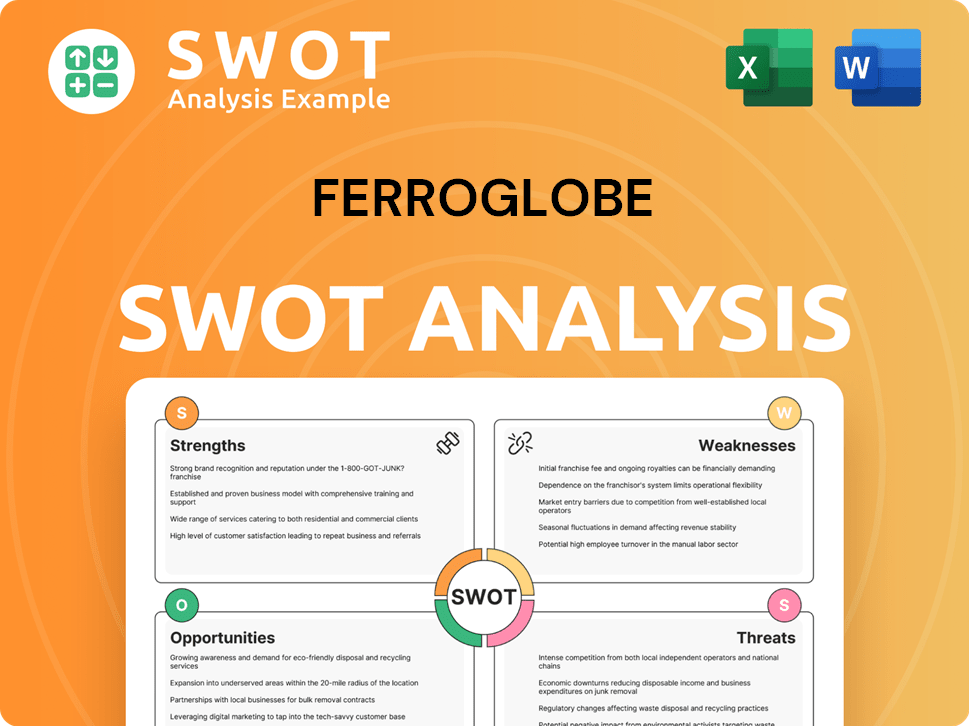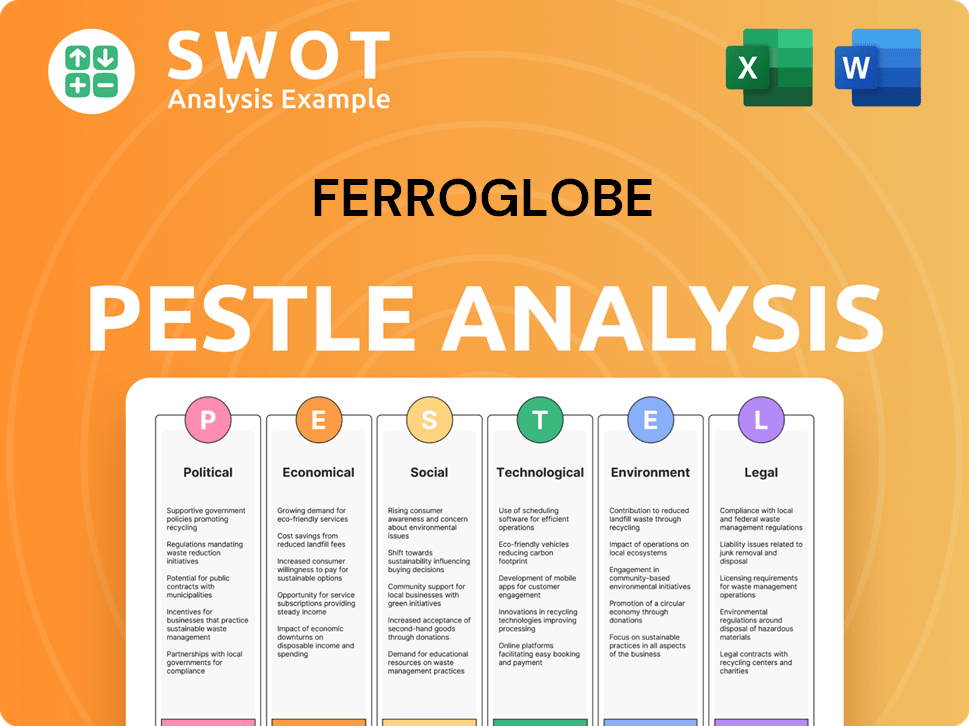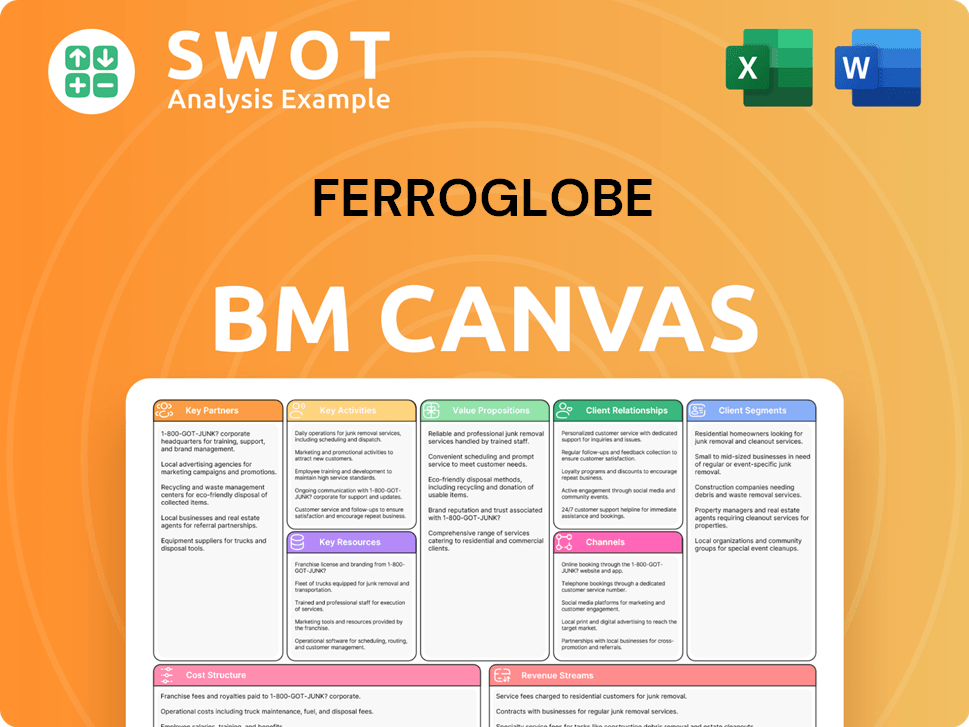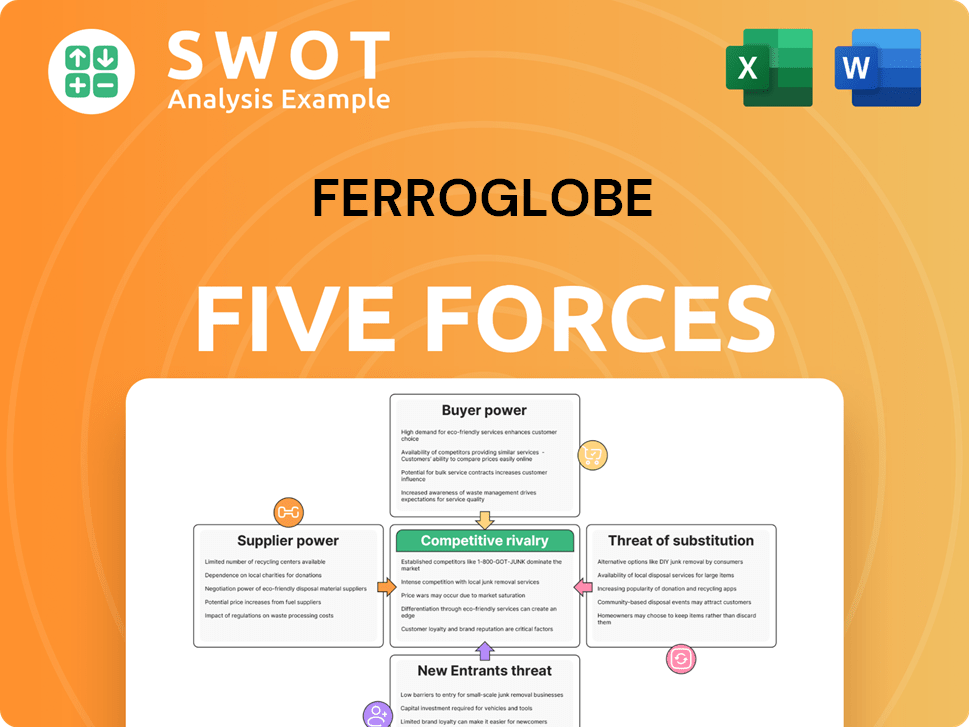Ferroglobe Bundle
Decoding Ferroglobe's Customer Base: Who Are They?
In the dynamic world of ferroalloys, understanding Ferroglobe SWOT Analysis and its customer demographics is crucial for strategic success. Ferroglobe's ability to adapt to shifts in its target market, particularly in sectors like solar energy and automotive, showcases its commitment to sustainable growth. This exploration delves into the core of Ferroglobe's business, examining its customer profile and the evolving needs of its diverse clientele.

This analysis of Ferroglobe's customer demographics and target market will provide valuable insights into the company's strategic positioning within the ferroalloys industry. We'll examine how Ferroglobe identifies its target market, including its customer segmentation strategies and global market presence. Furthermore, we'll explore Ferroglobe's marketing strategies for customer acquisition and retention, alongside its product applications and target industries, providing a comprehensive market analysis.
Who Are Ferroglobe’s Main Customers?
Understanding the customer demographics and target market of Ferroglobe is crucial for grasping its market position. Ferroglobe operates primarily in a business-to-business (B2B) model, focusing on supplying materials to various industrial sectors. Its target market is defined by the industries it serves, each with specific needs for silicon metal and ferroalloys.
The company's customer base is diverse, spanning several key sectors. These sectors include chemical products, aluminum, steel, solar energy, automotive, and foundries. Each sector has distinct requirements that Ferroglobe caters to with its specialized products. The growth potential in sectors like solar energy and automotive is significant, aligning with global trends toward sustainability and technological advancements.
Ferroglobe's strategy involves maintaining strong relationships with established industries while expanding into high-growth sectors to diversify its revenue streams. This approach, coupled with its global presence, allows Ferroglobe to meet the varied demands of its industrial customers worldwide.
Ferroglobe's primary customer segments include the chemical industry, which uses high-purity silicon metal for silicones. The aluminum sector utilizes silicon alloys for casting and alloying. The steel industry relies on ferroalloys to enhance steel properties. The solar energy sector demands high-purity silicon for photovoltaic cells.
The solar energy and automotive sectors represent significant growth areas for Ferroglobe. These sectors are driven by global sustainability trends and technological advancements. Ferroglobe likely invests in these sectors to capitalize on market opportunities and diversify its revenue streams.
Ferroglobe's global operational footprint allows it to cater to diverse industrial demands across different geographical regions. This global presence supports its ability to serve a broad customer base. The company's international reach is a key factor in its market strategy.
Each customer segment has unique material requirements and production processes. Ferroglobe tailors its products to meet these specific needs. The company's ability to adapt to these demands is critical for customer satisfaction and retention.
Ferroglobe's customer profile is defined by its industrial focus, with each sector having specific demands. The company's market analysis involves understanding the needs of the chemical, aluminum, steel, solar energy, automotive, and foundry industries. The company strategically targets these sectors to optimize its market share and revenue streams.
- The chemical industry uses silicon metal for silicones.
- The aluminum sector uses silicon alloys for casting.
- The steel industry uses ferroalloys for enhancement.
- The solar sector utilizes silicon for photovoltaic cells.
Ferroglobe SWOT Analysis
- Complete SWOT Breakdown
- Fully Customizable
- Editable in Excel & Word
- Professional Formatting
- Investor-Ready Format

What Do Ferroglobe’s Customers Want?
Understanding the customer needs and preferences is crucial for Ferroglobe. This involves a deep dive into the factors that drive purchasing decisions within the ferroalloys industry. The primary focus is on delivering value that aligns with the operational and strategic goals of its industrial clients.
The core of Ferroglobe's customer-centric approach lies in providing high-quality products and reliable service. This includes meeting stringent technical specifications and ensuring a consistent supply chain. The company's success hinges on its ability to adapt to evolving market demands and maintain strong relationships with its diverse customer base.
Ferroglobe's customers, who are primarily in the steel, automotive, and solar industries, prioritize material purity, quality consistency, and reliable supply. They often operate under long-term contracts, emphasizing the need for just-in-time delivery to maintain efficient production. Decision-making is influenced by alloy performance, the producer's reputation, logistical capabilities, and adherence to environmental standards.
Customers need material purity, consistent quality, and reliable supply. Competitive pricing and technical support are also essential. These needs drive the demand within the ferroalloys industry.
Purchasing behaviors are influenced by long-term supply contracts and technical specifications. Just-in-time delivery is crucial for maintaining efficient production lines. This impacts the customer profile.
Customers consider alloy performance, the producer's reputation, and logistical capabilities. Adherence to environmental and safety standards also plays a significant role. This is part of the market analysis.
Products are integrated into large-scale manufacturing processes, making reliability and consistency paramount. This affects the demographics of ferroalloy consumers.
Loyalty is built on trust, product performance, and strategic partnership. This is key to Ferroglobe's customer retention tactics.
Customers choose Ferroglobe for high-quality raw materials and operational efficiency. This influences Ferroglobe's ideal customer profile.
Ferroglobe addresses pain points by ensuring stable supply, providing technical expertise, and meeting industry specifications. This approach is crucial for understanding Ferroglobe's customer buying behavior.
- Stable Supply: Ensuring a consistent supply of materials despite market fluctuations.
- Technical Expertise: Offering technical support to optimize material usage.
- Industry Specifications: Meeting stringent industry standards and requirements.
- Adaptation: Tailoring production, such as silicon metal for solar-grade silicon, to meet specific segment needs.
Ferroglobe PESTLE Analysis
- Covers All 6 PESTLE Categories
- No Research Needed – Save Hours of Work
- Built by Experts, Trusted by Consultants
- Instant Download, Ready to Use
- 100% Editable, Fully Customizable

Where does Ferroglobe operate?
The geographical market presence of Ferroglobe is substantial, with production facilities strategically located across multiple continents. This global footprint allows the company to serve a diverse customer base efficiently. Key regions include Europe, North America, South America, and Asia, each playing a crucial role in its operational strategy.
Ferroglobe's market reach is deeply intertwined with the ferroalloys industry and the manufacturing bases of key sectors. Its facilities are positioned to cater to the needs of industries such as chemical, aluminum, steel, solar, and automotive. This strategic alignment ensures that Ferroglobe can meet regional demands effectively.
The company's operations are tailored to meet regional demands, ensuring that production facilities meet regional quality standards. Logistics are adapted to serve local customer requirements efficiently. This approach includes tailored delivery schedules and specific packaging to meet customer needs.
Ferroglobe operates production facilities in Europe (Spain, France, Norway), North America (United States, Canada), South America (Brazil), and Asia. These locations are strategically chosen to serve key markets and reduce transportation costs. The company's global presence is a key factor in its ability to serve its target market.
Market analysis is crucial for Ferroglobe to understand regional differences in demand. For instance, the demand for specific silicon grades varies based on the maturity of the solar industry in a particular region. This analysis helps the company tailor its product offerings and marketing strategies. Understanding Growth Strategy of Ferroglobe is key to market analysis.
Customer demographics vary across regions, primarily driven by industrial activities and regulatory environments. For example, the demand for specific silicon grades might vary based on the maturity of the solar industry in a particular region. This understanding helps Ferroglobe in customer segmentation strategies.
Ferroglobe's target market includes industries such as chemical, aluminum, steel, solar, and automotive. The company focuses on regions with robust manufacturing bases in these sectors. This strategic focus allows Ferroglobe to optimize its market share analysis and customer acquisition.
Ferroglobe localizes its offerings by ensuring production facilities meet regional quality standards. This includes adapting logistics to serve local customer requirements efficiently. Tailored delivery schedules and specific packaging are examples of this approach.
Strategic expansions or withdrawals are often linked to market demand shifts or the optimization of the production network. Investments in new facilities or upgrades are likely in areas with growing demand for specialized products. This approach ensures Ferroglobe remains competitive.
Europe, North America, and Asia are key markets for Ferroglobe. These regions have significant manufacturing bases in industries that utilize its products. These regions are crucial for Ferroglobe's revenue streams and customer base.
Ferroglobe's products are used in various applications, including steelmaking, aluminum production, and the solar industry. High-purity silicon is crucial for advanced applications. This diversification helps in identifying Ferroglobe's target audience by region.
The competitive landscape includes other ferroalloy producers and suppliers. Ferroglobe differentiates itself through its global presence, product quality, and customer service. This competitive approach helps in Ferroglobe's customer retention tactics.
Ferroglobe is increasingly focusing on sustainability initiatives to meet customer values and regulatory requirements. This includes reducing carbon emissions and promoting environmentally friendly practices. This approach is key to Ferroglobe's marketing strategies for customer acquisition.
Ferroglobe Business Model Canvas
- Complete 9-Block Business Model Canvas
- Effortlessly Communicate Your Business Strategy
- Investor-Ready BMC Format
- 100% Editable and Customizable
- Clear and Structured Layout

How Does Ferroglobe Win & Keep Customers?
Customer acquisition and retention for Ferroglobe, a major player in the ferroalloys industry, centers on a B2B approach. This strategy emphasizes building long-term relationships with industrial clients. The company's focus is on providing technical expertise and ensuring a reliable supply chain, crucial elements for retaining customers in this specialized sector.
Given the nature of the Growth Strategy of Ferroglobe, traditional marketing methods are less relevant. Instead, Ferroglobe relies on direct sales, participation in industry conferences, and engagement with trade associations. These channels facilitate direct interaction with procurement teams and R&D departments, enabling the company to highlight the technical specifications and value proposition of its alloys.
Customer loyalty in this sector is cultivated through consistent product quality, on-time delivery, and responsive customer service. Personalized experiences, including technical support and collaborative problem-solving, are also vital. After-sales service encompasses technical assistance, quality assurance, and addressing logistical challenges, all contributing to customer retention.
Direct sales teams engage with procurement and R&D departments of large industrial clients. This involves presenting technical specifications and the value proposition of Ferroglobe’s alloys. This direct approach allows for tailored solutions and relationship building.
Ferroglobe actively participates in industry conferences and trade associations to connect with potential and existing customers. These events provide opportunities to showcase products, network, and stay informed about industry trends and customer needs. This is a key component of their market analysis.
Consistent product quality and on-time delivery are fundamental to retaining customers in the ferroalloys industry. These factors build trust and ensure that customers can rely on Ferroglobe for their critical material needs. This is a crucial element of their customer buying behavior.
Providing technical support and collaborating with customers to optimize their processes is a key retention strategy. This involves offering expertise and helping customers maximize the benefits of Ferroglobe's materials. This collaborative approach strengthens customer relationships.
Customer data and CRM systems are essential for tracking interactions, managing contracts, forecasting demand, and identifying upselling or cross-selling opportunities. Segmentation by industry and specific material requirements allows for targeted communication and product development. A successful acquisition strategy often involves demonstrating superior product performance or a more secure supply chain compared to competitors. Innovative retention initiatives might include joint R&D projects with key clients to develop new materials or applications, further embedding Ferroglobe into their value chain.
Customer Relationship Management (CRM) systems are crucial for managing customer interactions, contracts, and forecasting demand. This data helps in identifying opportunities for upselling and cross-selling. Analyzing customer data provides insights into customer profile and market analysis.
Ferroglobe segments its customer base by industry and specific material requirements. This allows for targeted communication and product development, ensuring that the company meets the diverse needs of its customer demographics. This is a key component of how Ferroglobe identifies its target market.
Successful acquisition often hinges on demonstrating superior product performance or a more secure supply chain compared to competitors. This involves highlighting the unique value proposition of Ferroglobe's products and services in the competitive landscape. This is a key aspect of their market share analysis.
Innovative retention initiatives include joint R&D projects with key clients. These collaborations aim to develop new materials or applications, further integrating Ferroglobe into the customer's value chain. This strategy strengthens long-term partnerships.
Changes in strategy over time have included a greater emphasis on sustainability and ESG factors. These considerations are increasingly important for industrial customers, impacting customer loyalty and strengthening long-term partnerships. Ferroglobe is adapting to the evolving customer values.
Ferroglobe's global market presence enables it to serve a diverse customer base across various regions. The company's ability to provide consistent quality and reliable supply chains is critical to its success. This supports its revenue streams and customer base.
Ferroglobe Porter's Five Forces Analysis
- Covers All 5 Competitive Forces in Detail
- Structured for Consultants, Students, and Founders
- 100% Editable in Microsoft Word & Excel
- Instant Digital Download – Use Immediately
- Compatible with Mac & PC – Fully Unlocked

Related Blogs
- What are Mission Vision & Core Values of Ferroglobe Company?
- What is Competitive Landscape of Ferroglobe Company?
- What is Growth Strategy and Future Prospects of Ferroglobe Company?
- How Does Ferroglobe Company Work?
- What is Sales and Marketing Strategy of Ferroglobe Company?
- What is Brief History of Ferroglobe Company?
- Who Owns Ferroglobe Company?
Disclaimer
All information, articles, and product details provided on this website are for general informational and educational purposes only. We do not claim any ownership over, nor do we intend to infringe upon, any trademarks, copyrights, logos, brand names, or other intellectual property mentioned or depicted on this site. Such intellectual property remains the property of its respective owners, and any references here are made solely for identification or informational purposes, without implying any affiliation, endorsement, or partnership.
We make no representations or warranties, express or implied, regarding the accuracy, completeness, or suitability of any content or products presented. Nothing on this website should be construed as legal, tax, investment, financial, medical, or other professional advice. In addition, no part of this site—including articles or product references—constitutes a solicitation, recommendation, endorsement, advertisement, or offer to buy or sell any securities, franchises, or other financial instruments, particularly in jurisdictions where such activity would be unlawful.
All content is of a general nature and may not address the specific circumstances of any individual or entity. It is not a substitute for professional advice or services. Any actions you take based on the information provided here are strictly at your own risk. You accept full responsibility for any decisions or outcomes arising from your use of this website and agree to release us from any liability in connection with your use of, or reliance upon, the content or products found herein.